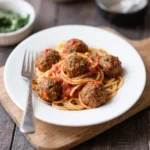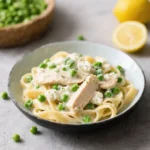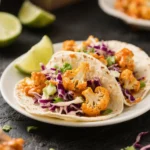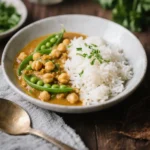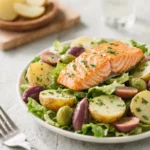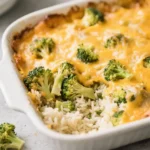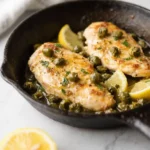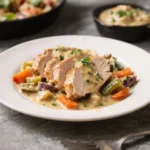Creamy Lemon Ricotta Chicken Pasta with Peas is a luscious, comforting dish that combines the bright freshness of lemon with the creamy richness of ricotta cheese. Perfect for weeknight dinners or impressing guests, this recipe brings together tender chicken, al dente pasta, sweet peas, and a velvety sauce that’s both light and indulgent. With its vibrant flavor profile and satisfying texture, it’s no wonder this dish has become a modern favorite in home kitchens across the globe.
The History
The origins of Creamy Lemon Ricotta Chicken Pasta with Peas can be traced back to the fusion of Italian culinary traditions and modern American comfort food sensibilities. While classic Italian cooking often features simple preparations with high-quality ingredients—such as fresh pasta tossed with olive oil, garlic, and Parmesan—the addition of ricotta to create a creamy sauce reflects regional influences from Southern Italy, particularly Sicily and Campania, where ricotta is used not only in desserts but also in savory dishes like ravioli fillings and baked pastas.
The incorporation of lemon into savory dishes is a hallmark of coastal Italian cuisine, especially in regions like Amalfi and Sorrento, where lemons are grown abundantly. The zest and juice of the fruit bring a bright acidity that cuts through rich ingredients, balancing the overall flavor. Over time, home cooks began experimenting by blending these elements—creamy ricotta, citrus notes, protein-rich chicken, and garden-fresh peas—into one harmonious meal.
In recent years, food bloggers and chefs have popularized this style of one-pan, creamy pasta dish as part of a broader trend toward “elevated comfort food”—meals that feel indulgent yet approachable, quick to prepare, and packed with flavor. The result? A modern classic: Creamy Lemon Ricotta Chicken Pasta with Peas, which celebrates Mediterranean flavors while fitting seamlessly into busy lifestyles.
Ingredients Breakdown
To achieve the perfect balance of creaminess, tang, and freshness in this dish, each ingredient plays a crucial role:
- Chicken Breast or Thighs: Boneless, skinless chicken breasts are most commonly used for their lean texture and mild flavor, though thighs offer more juiciness and depth.
- Pasta: Short shapes like penne, fusilli, or farfalle work best because they hold onto the creamy sauce and pair well with peas.
- Ricotta Cheese: Whole-milk ricotta provides a smooth, slightly grainy texture and rich mouthfeel without being overly heavy. It melts beautifully into the sauce.
- Lemons: Both the zest and juice are essential—zest delivers aromatic oils, while juice adds acidity and brightness.
- Frozen or Fresh Peas: Sweet and tender, peas add color, nutrition, and a pop of spring-like freshness.
- Garlic: Minced fresh garlic gives a pungent base note that enhances the entire dish.
- Olive Oil & Butter: Olive oil is used for searing; butter adds silkiness and rounds out the sauce.
- Chicken Broth: Helps deglaze the pan and creates a light, flavorful liquid base for the sauce.
- Heavy Cream or Half-and-Half: Adds body and creaminess, helping emulsify the ricotta into a smooth sauce.
- Parmesan Cheese: Grated Parmigiano-Reggiano deepens umami and saltiness, enhancing overall savoriness.
- Red Pepper Flakes (optional): For a touch of heat that contrasts the lemon’s tartness.
- Salt & Black Pepper: Essential seasonings to taste.
- Fresh Herbs: Basil, parsley, or chives make excellent garnishes, adding herbal complexity and visual appeal.
Step-by-Step Recipe
- Prepare Ingredients: Slice 1 lb (450g) boneless chicken into thin strips or bite-sized pieces. Mince 3 cloves of garlic. Zest and juice 1 large lemon (you’ll need about 2 tbsp juice and 1 tsp zest). Measure out 1 cup frozen peas (no need to thaw), 1 cup whole-milk ricotta, ½ cup grated Parmesan, and ¼ cup heavy cream. Have on hand 8 oz (about 2 cups) short pasta such as penne.
- Cook the Pasta: Bring a large pot of salted water to a boil. Add the pasta and cook according to package instructions until al dente. Reserve ½ cup of pasta water before draining. Set aside.
- Sear the Chicken: In a large skillet or Dutch oven, heat 2 tablespoons olive oil over medium-high heat. Season chicken with salt, pepper, and a pinch of red pepper flakes. Cook for 5–6 minutes, turning occasionally, until golden brown and cooked through. Remove chicken and set aside.
- Sauté Aromatics: In the same pan, reduce heat to medium. Add 1 tablespoon butter and the minced garlic. Sauté for 30 seconds until fragrant—do not let it burn.
- Build the Sauce Base: Pour in ½ cup low-sodium chicken broth to deglaze the pan, scraping up any browned bits. Let simmer for 1–2 minutes to reduce slightly.
- Add Cream & Ricotta: Stir in the heavy cream, then gradually whisk in the ricotta cheese until mostly smooth. Some small lumps are okay—they’ll melt further. Add lemon zest and half the lemon juice.
- Incorporate Peas & Chicken: Return the cooked chicken to the pan. Add the peas and stir gently. Simmer for 3–4 minutes until peas are heated through and sauce begins to thicken.
- Combine with Pasta: Add the drained pasta to the skillet. Toss everything together, adding reserved pasta water a few tablespoons at a time to loosen the sauce and help it coat every strand.
- Finish with Cheese & Seasoning: Stir in the grated Parmesan, remaining lemon juice, and additional salt and pepper to taste. Adjust consistency with more pasta water if needed.
- Garnish & Serve: Remove from heat. Sprinkle with chopped fresh basil or parsley, extra Parmesan, and a little more lemon zest for presentation. Serve immediately.
Tips
- Use Warm Ricotta: Take the ricotta out of the fridge 15–20 minutes before cooking. Cold ricotta can seize up when added to hot pans, leading to clumping.
- Don’t Skip the Pasta Water: The starchy liquid is key for creating a silky, cohesive sauce that clings to the pasta.
- Avoid Boiling the Sauce After Adding Ricotta: High heat can cause the ricotta to break or become grainy. Keep the heat at a gentle simmer.
- Brown the Chicken Well: Proper browning builds flavor through the Maillard reaction. Don’t overcrowd the pan—cook in batches if necessary.
- Zest First, Then Juice: It’s easier to zest a firm lemon before juicing it. Use a microplane for fine zest without bitter white pith.
- Taste Before Serving: Balance the flavors—add more lemon juice for brightness, salt for depth, or Parmesan for richness.
- One-Pan Option: For less cleanup, cook the chicken, sauce, and even the pasta (using the absorption method) all in one large pot or deep skillet.
Variations and Customizations
- Vegetarian Version: Omit the chicken and use vegetable broth. Add sautéed mushrooms, zucchini, or roasted cherry tomatoes for heartiness.
- Dairy-Free: Substitute ricotta with blended silken tofu or cashew cream. Use nutritional yeast instead of Parmesan and plant-based butter and cream.
- Gluten-Free: Use your favorite gluten-free pasta (like brown rice or chickpea penne) and ensure broth is certified GF.
- Seafood Twist: Replace chicken with cooked shrimp or scallops. Add them at the end to prevent overcooking.
- Herb Variations: Swap basil for dill or tarragon for a different aromatic profile, especially nice with peas.
- Extra Veggies: Stir in spinach, asparagus, artichoke hearts, or roasted red peppers during the final mixing stage.
- Spicier Kick: Increase red pepper flakes or add a dash of hot sauce like Calabrian chili paste for deeper heat.
- Make it Baked: Transfer mixture to a casserole dish, top with breadcrumbs and mozzarella, and bake at 375°F (190°C) for 15–20 minutes for a bubbly finish.
- Meal Prep Friendly: Assemble components separately and store; combine and reheat with a splash of broth or water to refresh the sauce.
Health Considerations and Nutritional Value
This dish can be adapted to suit various dietary needs while still delivering robust flavor. Here’s an approximate nutritional breakdown per serving (based on 4 servings, using chicken breast and whole ingredients):
- Calories: ~550–650 kcal
- Protein: 30–35g (excellent source from chicken and dairy)
- Fat: 20–25g (mostly from healthy fats in olive oil, ricotta, and Parmesan)
- Saturated Fat: ~8–10g (moderate; can be reduced with lower-fat alternatives)
- Carbohydrates: 55–65g (primarily from pasta; choose whole grain for added fiber)
- Fiber: 4–6g (enhanced with whole grain pasta and peas)
- Sugar: ~5g (naturally occurring from peas and milk)
- Sodium: ~500–700mg (manageable; control by using low-sodium broth and minimal added salt)
Key Nutrients: This dish offers a good balance of macronutrients and contains notable amounts of calcium (from ricotta and Parmesan), vitamin C (from lemon), vitamin K, iron, and B vitamins. Peas contribute plant-based protein and fiber, supporting digestive health.
Dietary Notes: To make it heart-healthier, use half ricotta and half low-fat cottage cheese blended smooth. For a lighter version, omit cream and rely on starchy pasta water and extra ricotta for creaminess. Diabetics may opt for legume-based pasta to lower glycemic impact. Always consult a healthcare provider or dietitian for personalized advice.
Ingredients
- 1 lb (450g) boneless, skinless chicken breasts or thighs, sliced into strips
- 8 oz (225g) short pasta (penne, fusilli, or farfalle)
- 2 tbsp olive oil
- 1 tbsp unsalted butter
- 3 garlic cloves, minced
- ½ cup low-sodium chicken broth
- 1 cup whole-milk ricotta cheese
- ¼ cup heavy cream or half-and-half
- 1 large lemon (zest and juice)
- 1 cup frozen peas (no need to thaw)
- ½ cup freshly grated Parmesan cheese, plus extra for serving
- Salt and freshly ground black pepper, to taste
- ¼ tsp red pepper flakes (optional)
- ¼ cup chopped fresh basil or parsley, for garnish
Directions
- Bring a large pot of salted water to a boil. Cook pasta according to package directions until al dente. Reserve ½ cup pasta water, then drain and set aside.
- Season chicken with salt, pepper, and red pepper flakes. Heat olive oil in a large skillet over medium-high heat. Add chicken and cook 5–6 minutes until golden and cooked through. Transfer to a plate.
- Reduce heat to medium. Melt butter in the same skillet. Add garlic and sauté for 30 seconds until fragrant.
- Pour in chicken broth to deglaze, scraping up browned bits. Simmer 1–2 minutes.
- Stir in heavy cream, then gradually whisk in ricotta until smooth. Add lemon zest and 1 tbsp lemon juice.
- Return chicken to the skillet. Add peas and simmer 3–4 minutes until heated through.
- Add cooked pasta and toss to combine. Gradually add reserved pasta water (3–4 tbsp at a time) until sauce coats the noodles smoothly.
- Stir in Parmesan, remaining lemon juice, and season to taste with salt and pepper.
- Remove from heat. Garnish with fresh herbs, extra Parmesan, and a sprinkle of lemon zest.
- Serve warm, ideally with crusty bread or a side salad.
FAQ
Can I use low-fat ricotta?
Yes, but full-fat ricotta gives the creamiest texture. Low-fat versions may result in a thinner, less luxurious sauce.
Can I make this ahead of time?
Best served fresh, but you can prep components separately. Reheat gently with broth or water to restore creaminess.
Why is my sauce grainy?
This usually happens if the ricotta is too cold or the heat is too high. Warm the ricotta first and keep the sauce at a simmer, not a boil.
Can I freeze leftovers?
Dairy-based sauces don’t freeze well—they may separate upon thawing. Store in the fridge for up to 3 days and reheat carefully.
What can I substitute for ricotta?
Cottage cheese (blended smooth), mascarpone, or goat cheese can work, though each alters the flavor slightly.
Is this kid-friendly?
Absolutely! The mild sweetness of peas and creamy texture appeal to children. You can reduce lemon or spice to suit younger palates.
Can I use dried herbs instead of fresh?
Fresh herbs are preferred for brightness, but you can substitute 1 tsp dried basil or parsley if needed.
Summary
Creamy Lemon Ricotta Chicken Pasta with Peas is a harmonious blend of zesty citrus, velvety dairy, tender chicken, and sweet vegetables—all wrapped in a luxuriously smooth sauce. Quick to make, endlessly customizable, and bursting with flavor, it’s a modern comfort dish that feels both wholesome and indulgent.

